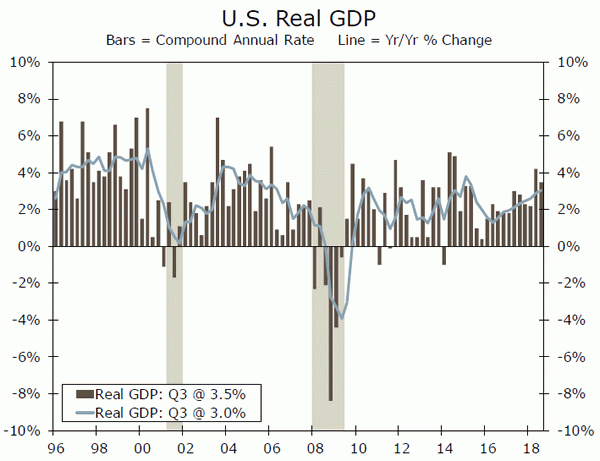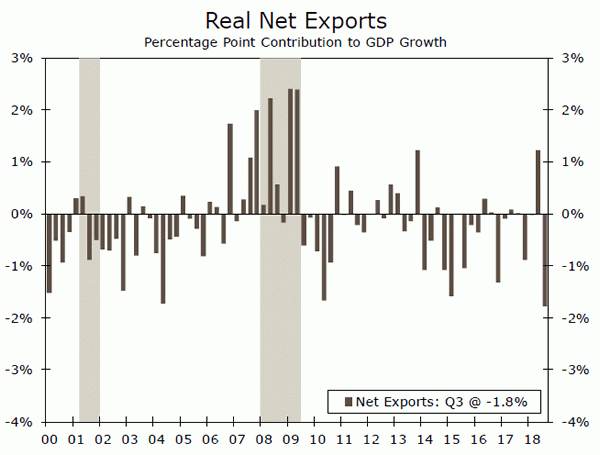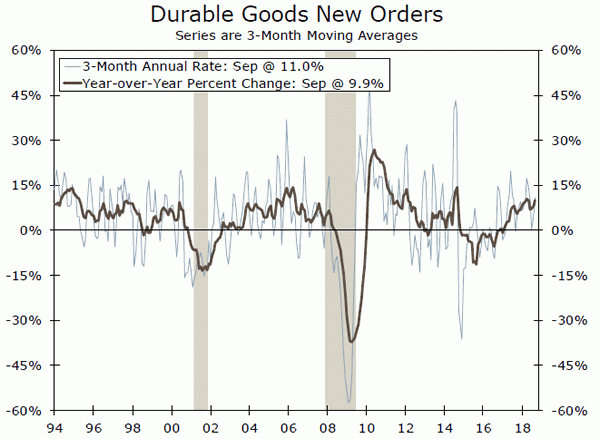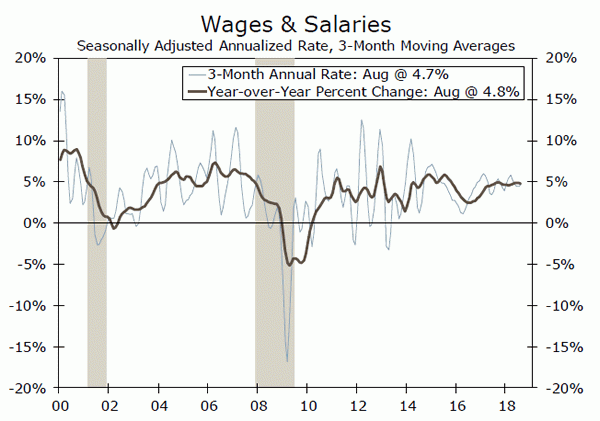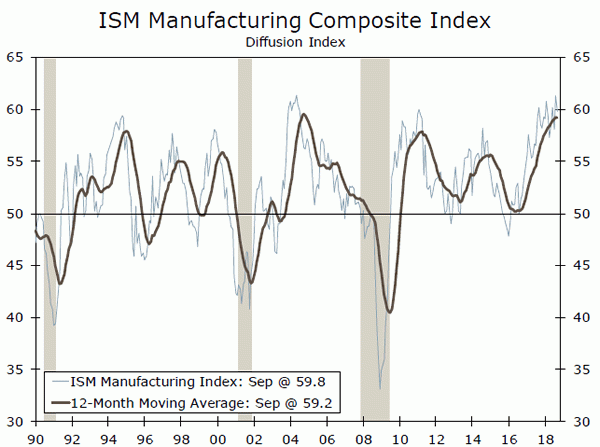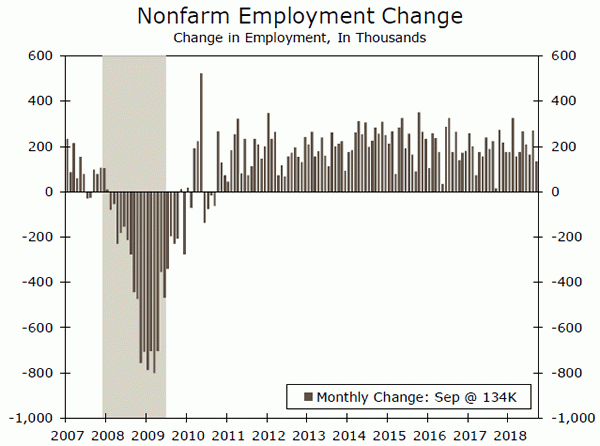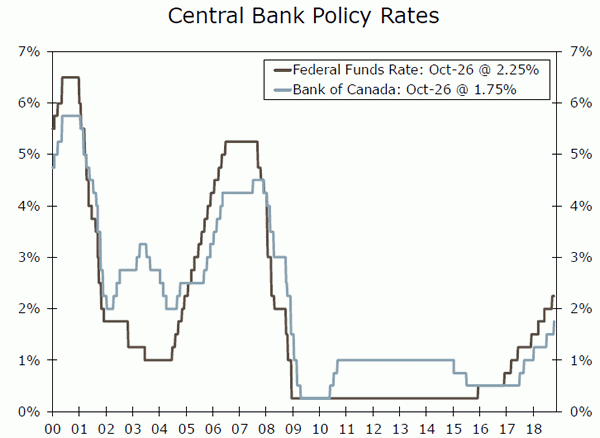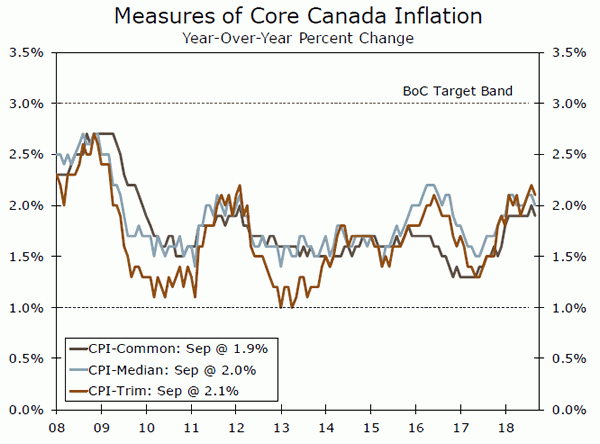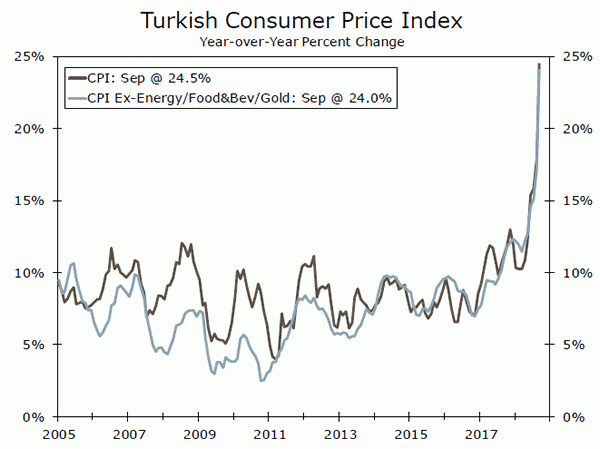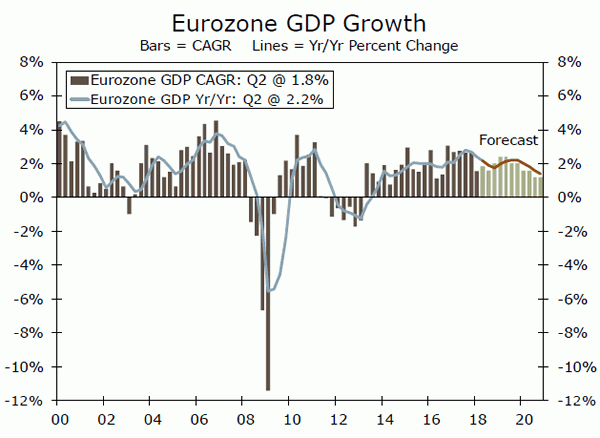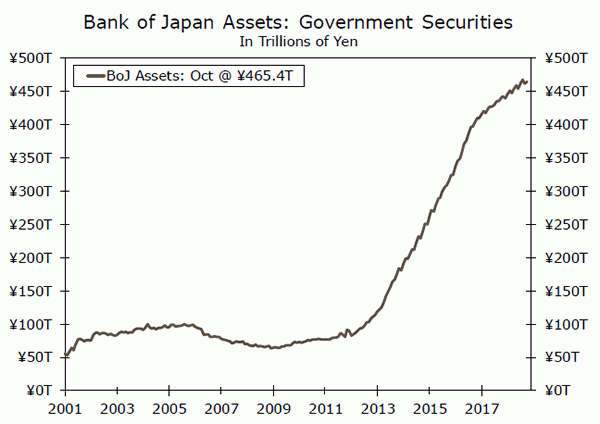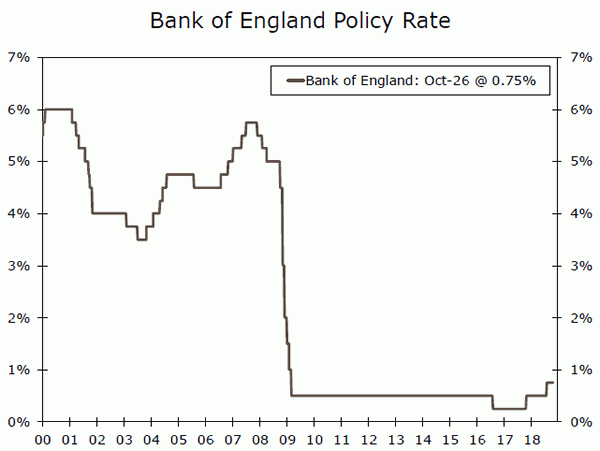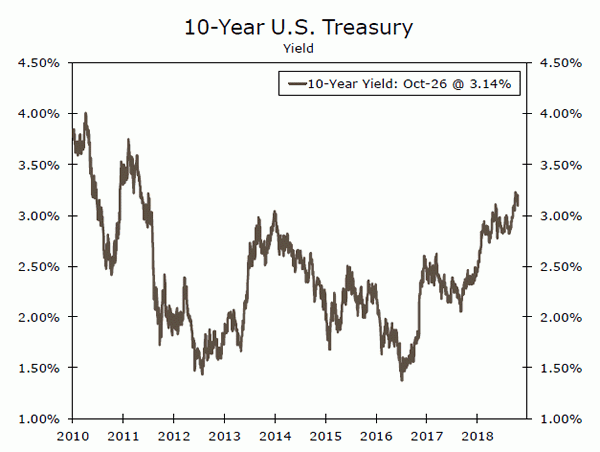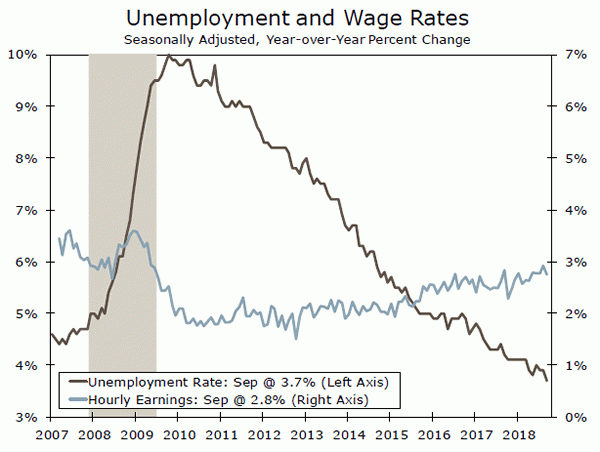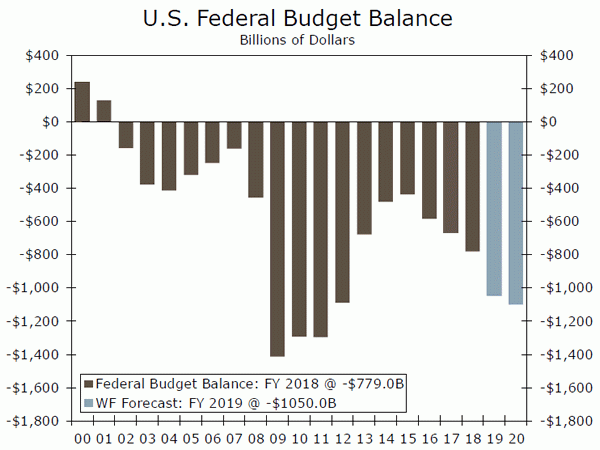U.S. Review
GDP Growth Remains Solid in Q3
- Real GDP topped expectations and grew 3.5% in Q3. Consumer and government spending remained strong, and inventories also provided a substantial boost. Fixed investment and net exports were a drag.
- The weakness in housing continued in September, as new home sales declined 5.5% to a 553,000-unit pace. The Pending Home Sales Index rose 0.5%, indicating that existing homes sales may see some improvement in coming months.
- Durable goods orders grew 0.8% in September. Core capital goods orders fell 0.1%, the second consecutive monthly decline, which suggests business investment spending may be slowing.
GDP Growth Remains Solid in Q3
The third quarter print of GDP data dominated an otherwise slow week of economic data. Real GDP topped consensus expectations and grew a solid 3.5% in Q3. The outturn represents a modest downshift from the 4.2% registered in Q2; however, the U.S. economy continues to grow at a strong rate that is likely above the long-run potential rate. We look for some further slowing in the quarters ahead. However, the recent solid pace of expansion will likely lead the Federal Reserve to continue raising rates at a gradual pace given the still-strong labor market and inflation steadily trending higher.
Consumer and government spending remained strong in Q3, while fixed investment and net exports were a drag. Real personal consumption expenditures rose 4.0%, driven in part by the boost to disposable income that was delivered by reductions in personal income tax rates earlier this year. The effects of fiscal stimulus showed up in a 3.3% jump in government spending, the strongest sequential rate of growth in more than two years. An added boost was provided by a rebuild of inventories amounting to $76 billion, which added 2.1 percentage points to the overall GDP growth rate.
Not everything in the report was positive. Fixed investment spending declined 0.3% on a dip in both nonresidential structures and residential fixed investment, which fell 7.9% and 4.0%, respectively. Deteriorating affordability and higher building costs may by exerting some drag on the housing market. Business spending was stronger elsewhere, as real spending on intellectual property grew 7.9% and spending on equipment edged up 0.4%. Net exports were also another area of weakness in Q3, shaving off 1.8% from the topline GDP growth rate, a reversal from the tariffinspired jump in exports in Q2.
The weakness in the housing sector continued in September as new home sales declined 5.5% to a 553,000-unit pace. New home sales have fallen for five out of the past six months. The West registered a 12% drop, while the South posted a smaller 1.5% decline. Inventories rose for the sixth consecutive months to a 7.1 months’ supply, the highest since 2011. New home prices also dropped as the median price fell 3.5% year-over-year.
New home sales are up 3.4% on a year-to-date basis and are faring slightly better than existing homes sales, which are trending lower relative to their year-ago pace. However, a 0.5% rebound in September’s Pending Home Sales Index indicates that existing homes sales may improve in coming months. Pending home sales are based on signed contracts and lead existing home sales by roughly two months.
Meanwhile, there were signs that business spending may be slowing, although the trend has been firmly positive. Durable goods orders came in stronger than expected and rose 0.8% in September. Much of the gain occurred from a nearly 120% surge in defense orders. Aside from defense, orders were more modest. Transportation orders rose just 1.9%, while civilian aircraft orders dropped 17.5%. Orders for non-defense capital goods excluding aircraft fell 0.1%, the second consecutive monthly decline. Shipments of core capital goods orders have also stalled recently and have been flat in each of the past two months.
U.S. Outlook
Personal Income & Spending • Monday
With this morning’s Q3 GDP release, we learned that personal consumption expenditures rose 4.0% over the quarter. Continued strength in consumption partly reflects the boost to disposable incomes from tax cuts earlier this year. On Monday, we will receive September personal income and spending data. The strength exhibited in Q3 consumption, however, all but guarantees roughly a 0.3% nominal rise in personal spending for September.
The wages and salaries component of income posted its largest monthly increase since January in August, and while Hurricane Florence weighed on employment growth in September, the undeniably tight labor market appears to finally be translating to improvement in wages. Even with wage gains, however, energy prices remain elevated, which may have held back overall spending for September.
Previous: 0.3% & 0.3% Wells Fargo: 0.4% & 0.3% Consensus: 0.4% & 0.4%
ISM Manufacturing • Thursday
Following a 14-year high in August, manufacturing activity moderated in September. The September ISM slowed to 59.8, a stillelevated reading of activity. The slip was mostly due to moderation in the supplier deliveries, inventories and new orders components. This suggests that while supply chains are still tight, they are not as constrained as they were earlier this year. Similarly, the modest drop in the new orders index to 61.8 remains consistent with growth in factory orders, albeit at a more moderate pace. Despite shortages in labor and materials, the production and employment components of the index continued to rise last month. However, anecdotal evidence from respondents’ comments highlighted rising input costs and supply constraints attributable to tariffs and labor shortages starting to weigh on activity. We expect the ISM to further moderate to 59.1 in October, as manufacturers continue to face production constraints.
Previous: 59.8 Wells Fargo: 59.1 Consensus: 59.0
Employment • Friday
We expect employers to add roughly 200,000 payrolls in October, keeping the unemployment rate steady at 3.7%. This would follow a more modest increase of only 134,000 new jobs in September. Hurricane Florence was largely to blame for the depressed job growth last month, however, as about 300,000 workers said they were unable to work due to bad weather. This is compared to an average of 85,000 workers in a typical September. Other indicators suggest no signs of a cooling labor market. Demand for workers remains exceptionally strong, but that comes with increasing labor shortages. Last week, we learned that job openings continued to climb, breaching 7 million in August. The share of firms with a job opening that is hard to fill remains at a record high, while initial jobless claims remain among at the lowest levels since the late 1960s. Shortages of labor are likely pushing firms to raise wages.
Previous: 134,000 Wells Fargo: 200,000 Consensus: 187,000
Global Review
Monetary Policy Convergence Remains Slow and Steady
- Central bank decisions this week reinforce the still-gradual pace of monetary policy convergence, amid signs of muted growth prospects and ongoing trade and political uncertainty.
- The Bank of Canada raised rates 25 bps, and upwardly revised its business investment and export forecasts after the recent trade agreement removed much of the uncertainty surrounding North American trade policy.
- The European Central Bank remained on hold, reiterating its plans to end asset purchases by the end of the year but maintain current rates through summer 2019. Central banks in Sweden, Norway, Turkey and Russia also left policy unchanged.
Monetary Policy Convergence Remains Slow and Steady
Several central bank decisions this week highlight the still-gradual pace of global monetary policy convergence. Arguably the furthest along its tightening path relative to the U.S. is the Bank of Canada (BoC), which delivered a widely-expected 25 bps rate hike this week (see chart on page 1). The new U.S.-Mexico-Canada Agreement reached earlier this month largely removed uncertainty surrounding North American trade policy, leading the BoC to upwardly revise its business investment and export forecasts. However, U.S.-China trade tensions remain a concern, and the BoC continued to highlight these tensions as a risk to its outlook.
That said, in the near term several indicators signal that the Canadian economy is firing on all cylinders. The labor market remains tight, and although wage growth has slow slightly, it still remains solid and should position most consumers to withstand tighter financial conditions. In terms of inflation, a weaker CPI print of 2.2% year-over-year in September does not seem to be a major cause for concern for the BoC, as it was largely due to seasonal factors (top chart). Although the BoC dropped language from its statement regarding the gradual pace of policy tightening, we still see the BoC tightening policy in an orderly fashion, and look for three rate hikes in 2019.
While the BoC continues to tighten, several central banks in Europe remained on hold this week amid signs of muted growth prospects, ongoing trade tensions and political uncertainty. The European Central Bank (ECB) left policy unchanged, and while it continued to state it will wrap up its bond-buying program at the end of this year, it also reinforced plans to hold rates at their historic lows through at least summer 2019. In the press conference following the decision, ECB President Draghi noted that incoming data came in slightly weaker than expected since the last meeting, although he still characterized risks to the outlook as broadly balanced.
Consistent with Draghi’s rhetoric around weaker data, preliminary estimates for the Eurozone October Markit PMIs released this week missed consensus expectations, with the manufacturing PMI dropping to 52.1, its lowest reading since 2016 (middle chart). In our view, subdued growth across the Eurozone combined with only gradually rising inflation gives the ECB little cause to speed up policy normalization. We take the ECB at its word that it could begin to hike rates after summer 2019, although slower export growth amid trade tensions, concerns of a “hard” Brexit and the Italian budget debate remain risks worth monitoring.
Elsewhere in Europe, Sweden’s Riksbank left rates unchanged, although inflation is at target and the central bank looks for GDP growth of 2.3% in 2018, up from 2.1% last year. Policymakers reiterated their guidance on policy normalization from the last meeting, stating the first rate hike could come in December or February. Norway, Turkey and Russia’s central banks also remained on hold. However, in Turkey, still-rampant inflation that surpassed 24% in September signals that further rate hikes may be in store (bottom chart). Policymakers in Russia also highlighted upside risks to inflation and the potential for further hikes.
Global Outlook
Eurozone GDP • Tuesday
Real GDP in the Eurozone rose 0.4% in Q2, continuing the more sluggish pace of growth seen so far this year after an upside breakout in 2017. While fixed investment spending rebounded 1.2% in Q2 after rising at a more tepid pace in Q1, growth in the consumer sector slowed, and exports only rebounded slightly after declining in Q1.
The picture does not look to have changed materially in Q3, as several higher frequency indicators continue to point to a more moderate pace of growth. Preliminary October PMI readings came in below consensus estimates, while retail sales declined in July and August. That said, we look for the Eurozone economy to continue to expand at a moderate pace in coming quarters, as the labor market remains solid and financial conditions continue to be accommodative. Also due next week are preliminary October inflation data and October confidence indices.
Previous: 0.4% Wells Fargo: 0.4% Consensus: 0.3%
Bank of Japan Decision • Wednesday
The Bank of Japan (BoJ) has maintained highly accommodative policy for several quarters amid low inflation and more moderate GDP growth. While the economy contracted slightly in Q1, a solid Q2 rebound was led by a pickup in business investment, which should be supportive of longer-term growth prospects. The labor market has also tightened in recent months, and gradually rising wages should be supportive of further growth in consumer spending.
But inflation is likely more of a near-term concern for the central bank, as core CPI inflation remains stuck around 1%, well below the BoJ’s 2% target. As such, interest rates have remained in negative territory and the BoJ has maintained its extensive bond-buying program, with total assets on its balance sheet amounting to nearly 100% of GDP at present. We look for the BoJ to keep policy highly accommodative for the foreseeable future, until inflation begins to show signs of a sustained upward trend.
Previous: -0.10% Wells Fargo: -0.10%
Bank of England Decision • Thursday
After raising rates 25 bps at its August meeting, we look for the Bank of England (BoE) to remain on hold at its meeting next week. The BoE is likely in the midst of a balancing act, managing still abovetarget inflation along with continued Brexit uncertainty.
In terms of the former, consumer price inflation still remains above the BoE’s 2% target, but has come down significantly from its high of nearly 3% earlier this year, up 2.4% in September year-over-year. As price pressures have receded, real wage growth is showing signs of gradually picking up, which should be supportive of future growth prospects, especially after household spending growth slowed in Q2. However, with Brexit negotiations still underway and uncertainty surrounding the feasibility of reaching a deal by the March 2019 deadline, we believe the BoE will continue to adopt a wait-and-see approach before hiking rates.
Previous: 0.75% Wells Fargo: 0.75% Consensus: 0.75%
Point of View
Interest Rate Watch
Cross Currents
The bond market continues to take its cue from the stock market, with yields pulling back on days stocks sell off and rising on days stocks rebound. The earnings data have been mixed, with several large industrial firms reporting strong numbers but warning that tariffs are weighing on margins and also noting that global growth appears to be slowing. The yield on the 10-year Treasury security peaked earlier in the month at 3.23%, under a barrage of solid economic reports and hawkish statements by Fed officials.
This morning’s GDP data provide some new reference points. Real GDP grew at a 3.5% pace in Q3 and has averaged a 3.3% pace so far this year. With growth strengthening, inflation has firmed up, with the GDP deflator rising at a 1.7% pace in Q3 and rising 2.3% over the past year. The core personal consumption deflator rose at a 2.1% pace in Q3. While inflation has firmed, there is little in the data to suggest that it is likely to become problematic over the next few quarters. We look for growth to moderate in Q4, as interest-rate sensitive areas such as home sales, motor vehicle sales and business fixed investment weaken.
The Fed has become slightly more nuanced in its public comments given the volatility in the financial markets. While its earlier bullishness was genuine and likely aimed at firming up bond market expectations for rising interest rates, the Fed may have gotten more than it bargained for. The weakness in the housing market, which saw new home sales tumble 5.5% in September, is now really beginning to bite. Residential investment will likely subtract from economic growth every quarter this year.
The coming week will provide our first look into the fourth quarter. Manufacturing appears to be slowing and that may soon become apparent in the ISM survey. Friday’s jobs data should also show average hourly earnings up more than 3% year-overyear. Since wage growth has been so elusive throughout this expansion, firming average hourly earnings may further stoke fears that wages and inflation are set to rise now that the economy has blasted past traditional measures of full employment.
Credit Market Insights
CRE Lending Continues to Grow
According to the Mortgage Bankers Association, total commercial and multifamily mortgage originations grew 2% year-over-year in the first half of 2018. Fannie and Freddie collectively saw a 14% rise, while life insurance company originations grew 7%. Meanwhile, CMBS and commercial portfolio originations declined. While these traditional lenders hold roughly 88% of outstanding mortgage debt, non-traditional lenders are increasingly playing a large role. Loans from REITs, debt funds, and specialty finance companies increased 12% during that same time period. Delinquency rates across every class of lender remain exceptionally low. Solid economic growth is boosting occupancy and keeping upward pressure on rents, which is making conditions favorable for further lending. The value of total outstanding mortgage debt picked up in the first half of the year to a pace not seen since 2007, rising to just north of $1.3 trillion.
The rise in lending can be attributed to strong investor demand for hotels and multifamily properties, the value of which grew 22% and 17%, respectively. Occupancy at hotels is at near record highs, driven by strong consumer spending and elevated corporate profits. Demand for apartments has also been reignited as home prices and mortgage rates continue to climb. Lending also rose slightly for retail properties, increasing 1%, a sign that the sector may be rightsizing. Office, industrial and health care loans were all lower in the second half of 2018 compared to the year prior.
Topic of the Week
The Midterms and Our Economic Outlook
The 2016 United States election was a landmark event, and its impact has rippled through nearly all asset classes and the domestic and global economies. On November 6, 2018, Americans will go back to the polls for the midterm elections. Might this round of elections have similarly significant financial market and economic consequences?
In short, we are skeptical the 2018 midterms will match the 2016 election in terms of sweeping macroeconomic implications. The 2016 election was a watershed election, and it resulted in the first “unified government” (i.e., one party controlling the White House and both chambers of Congress) since 2009-2010 and the first Republican unified government since 2005-2006. Generally speaking, the move from divided government to unified government opens up more possible policy outcomes as one party unites to pass landmark legislation. As we look to the other side of the 2018 election, the two possible outcomes are a move from unified government to divided government or a continuation of the status quo. Regardless of which occurs, we believe these two outcomes are less likely to produce a clear inflection point in the nation’s fiscal policy, as happened in 2016.
More specifically, the tax cuts enacted at the end of last year are unlikely to be repealed or significantly expanded, in our view. In addition, unless the economy begins to decelerate markedly, we are also skeptical the stars will align for another discretionary spending increase as large as the one that Congress passed in Q1-2018. Even without additional tax cuts/spending increases, we look for the FY 2019 federal budget deficit to widen to $1.05 trillion, from $779 billion in FY 2018. The United States-Mexico- Canada Agreement (USMCA) to replace the North American Free Trade Agreement (NAFTA) will likely see a vote in 2019, although a divided government could make this a bit more of a rocky process.




